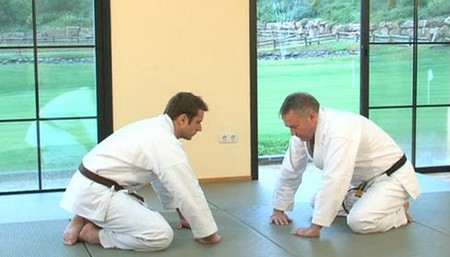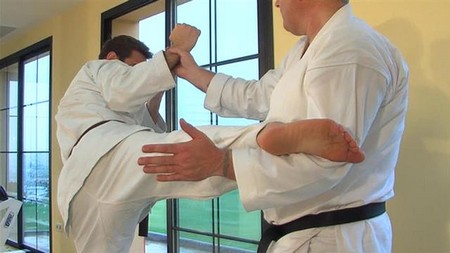Probably more time is spent on maintaining a high level of etiquette in the martial arts than in any other sport. Certainly, martial artists are expected to go beyond a mere handshake, which is probably the most common, and in some sports only, means of showing good sportsmanship. Though the degree of etiquette varies from school to school, I’ve not seen any school that doesn’t expect its students to show respect for their peers and the teacher by bowing to, thanking, acknowledging, and encouraging fellow students.
This type of formalized behavior acts as a balancing agent against the inherent aggressive nature of the sport. It’s difficult to remain angry at someone who accidentally hits you after he gives you a sincere handshake following the match. And by formally reaching out your hand to your opponent before a sparring match, you’re introducing the human element into what is taught to be an nonemotional exercise. (During your training, you’ll be sure to hear your instructor telling you numerous times to wear an expressionless face as you spar—whether you take a hit or you throw a perfect one into your opponent.)
Bowing is probably the most-used gesture of respect in the martial arts. For example, it signals the beginning or end of something. Students bow before a sparring match, then afterward. Bowing is also commonly done before and after stepping onto the training floor, and perforrning prearranged forms and one-on-one practice drills.
Bowing is also done when greeting other students, and not just high-ranking ones. Some schools may only require that students bow before high-ranking students, but it doesn’t hurt to get into the habit of bowing before all students. In fact, once you enter the school, the formalities typically start. A scenario might go like this: You enter the school and bow toward the floor before entering the dressing room. (You would also take off your shoes prior to entering the dressing room if you have to walk on the training floor to get to the room.) If you pass students along the way, you’re likely to have to bow to them and greet them with a traditional “Oss,” which is a common greeting used in some martial schools a is the English equivalent of saying hello. Once in the dressing room, it is fairly informal—probably the most informal room in the school. Still, it doesn’t hurt to greet everyone there with an “Oss” minus the bow.
Once you leave the dressing room, you’ll bow before stepping onto the training floor. Then, again, you’ll greet fellow students with a bow and an “Oss”—and perhaps even a handshake. Most schools limit conversation to short familiarities, followed by talk related to the martial arts: “Can you help me with my kata?” “I was practicing my blocks, and was having trouble keeping my wrist straight. Can we work on it together? and so forth.
Whether you work with a partner or decide to work on some moves solo prior to class, take a moment to assess where you will sit when the teacher instructs students to line up. This will make it easier to find your place. In many schools, it is actually more difficult for the low-ranking belts to determine where they will fall in line because they often fall at back of the line. What’s more, all students are expected to line up quickly. In my school, black belts sit up front with the instructor, facing the rest of the students. The highest brown belt takes her place at the front of a line facing the instructor and black belts, with the next highest-ranking student standing to her right, and so on until four or five students fill the first line. Then the next highest-ranking student starts a second line by taking her place behind the highest-ranking brown belt, and so on until the lowest ranking student falls into line in the back.
If you were a white belt trying to figure out where you fall into line, you would in this case count the number of higher-ranking belts, keeping in mind any students still in the dressing room who might make it out in time to line up, then determine the number of white belts who joined the school before you, as they are considered more advanced than you. Now you have the number of students who line up before you. You can also simply locate the student who precedes you in rank, wait until he or she lines up, then fall into place behind him or her—but then you are relying on that student’s ability to figure out your place in line.
Once the instructor walks onto the floor, students stop whatever it is they are doing, then upon his command, they line up according to rank, standing rigid with arms shooting straight down at their sides, hands clenched in a fist. The instructor then stands at the head of the class, sometimes with the black belts, depending on the school. He indicates for the class to bow, then sit on the floor. Once seated, students are instructed by the teacher to meditate for a minute or two, followed by a bow from the seated position. Then students stand and begin their warm-up exercises.
As explained before, during classes like Adults Martial Arts Classes, you’ll bow several times, before and after one-on-one takedown drills, katas, and sparring matches. When class ends, you’ll sit according to rank once again, and meditate and bow. You’ll also bow before leaving the floor, and then perhaps as you leave the school.
Just entering and leaving the school, and passing, say, two students each way, you’ll bow six times. Say during the class you perform five katas, spar three times, and practice four takedown drills, you’ll bow another twenty-four times. That’s a total of thirty bows per class! Therefore, it pays to know how to do it correctly.
Bowing looks simple, until you try it for the first time. Most new students make the same mistakes: staring at the floor as they bend down, bowing too quickly, pushing their shoulders upward, and slapping their arms against their sides before bowing as though they are in the army, not the dojo, and a sergeant is asking them to snap to attention.
To bow from a standing position, place your feet together at the heels with the toes pointing outward at about a fifteen-degree angle. Standing straight with the chin tucked in, mouth lightly closed, shoulders lowered, arms at the sides with the hands open, thumbs tucked in, and palms resting on the thighs, bend at the waist at a fifteen-degree angle, keeping a straight line from the head to the hips. Pause for a couple of seconds before raising yourself back to the original straight standing position. All of this should be performed in one breath.
Bowing from a sitting position is similar to that of a standing position. Students are generally required to bow from a seated position at the beginning and end of class, as well as during class when students work one-on-one from a seated position, practicing wrist grabs and other moves that concentrate solely on hand technique. Bowing from a seated position is basically the same as from a standing position. From a formal seated position—sitting on the backs of your shins—with the palms of the hands resting lightly on the thighs, slide down the hands to the floor, with the hands pointed slightly inward and the tips of the index fingers slightly apart. Lean forward as the hands and forearms touch the floor lightly. While bowing, keep your backside seated. After bowing, return to the upright formal seated position, returning your hands to their original position and looking straight in front of you.
One thing to remember about bowing: It signals respect, not gullibility. As you lean forward at the waist from a standing position, don’t take your eyes off your opponent. Your opponent probably won’t take a swing at you while you’re bowing, but at one time in the history of the sport, it was not unheard of. Also, do not let the quiet, slow pace of a bow put you off guard. I’ve seen students use bowing to their advantage. Just before a sparring match, as both students rise slowly from their bows, then get in the ready positions, one student will quickly pounce on her opponent the instant the instructor gives the command to begin sparring. Nine times out of ten, the other student, still at ease from bowing, will be taken completely by surprise, and lose the point.
Another advantageous way to use a bow is while performing it. A powerful look thrown as you bend down and find yourself face to face with your opponent can be almost as offsetting as a strong punch. Just compare the difference in eye contact between a new student and a high-ranking student. New students bowing before their partners often wear a frightened, submissive look. You can almost hear them thinking, “Please don’t hurt me.” High-ranking students generally keep their eyebrows steady and chin tucked in, and look straight into their opponent’s eyes, wearing a serious, I-mean-business expression.
Don’t be like a lot of students who eventually consider bowing unnecessary—like drivers who don’t bother signaling a lane change. As with all martial arts etiquette, bowing maintains tradition and discipline. Bowing also acts as a balancing agent, offsetting the aggressive nature of the sport with civilized behavior.
There are times, however, when etiquette takes a backseat to more important matters. It’s okay to step off the floor without bowing if you feel you’re going to get sick. It’s also all right to stop sparring in the middle of a match if you get injured and feel you’ll only worsen the injury if you continue.
I remember the first time I had the air knocked out of me during a sparring match. I lay on the floor in disbelief that I had been hit and that it was so difficult to catch my breath. I certainly wasn’t worrying about finishing the match, and neither was my instructor.

